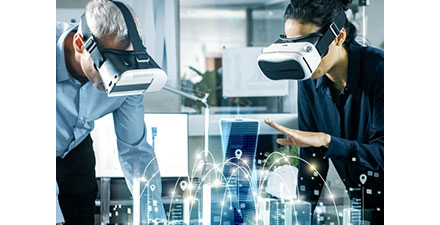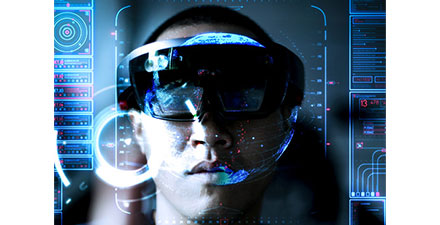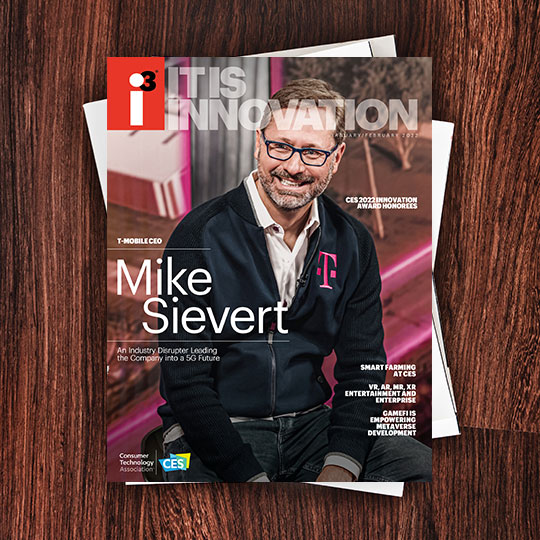The frenzy about “metaverse” immersion, an implementation of VR, has triggered a quest to understand the lingo of digital alternative realities. CTA’s AR-VR Working Group has formulated distinctions about the terminology, although in the fast-changing environment, meanings may shift. For now:
Virtual Reality (VR) creates a digital environment that replaces the user’s real world.
Augmented Reality (AR) overlays digitally created content onto the real-world environment.
Mixed Reality (MR) — which sometimes seems similar to AR — seamlessly blends the user’s real-world environment and digitally created content, where both environments can coexist and interact with each other.
XR is an umbrella term to cover all of the above plus yet unknown (X) Realities. XR sometimes is used to describe “extended reality,” which also encompasses the full spectrum of immersive technologies, including VR, AR and MR.
Steady Growth Expected
Several other XR evaluations paint a promising outlook for both the entertainment and enterprise versions of the technology.
According to Fortune Business Insights, the global VR market is projected to grow from $6.30 billion in 2021 to $84.09 billion in 2028; a compound annual growth rate (CAGR) of 44.8%.
Allied Market Research, focusing on the global mobile augmented reality (MAR) sector, predicts growth from $12.6 billion in 2020 to $184.6 billion by 2030, with North America expected to be the leading developer. The report calls MAR the “most popular and convenient form of AR” because of the proliferation of mobile devices.
These forecasts coincide with a period of growth and reevaluation for the XR world. For example, Magic Leap, a pioneering entertainment firm, has repositioned itself as an enterprise solution in industries such as healthcare, manufacturing and defense after scraping its initial plans to develop a consumer AR product.
Facebook’s transformation into a “multiverse” company has spurred countless interpretations, with its plans to hire 10,000 people and spend $10 billion in the coming year to start building the AR/VR/meta tech portion of the new Meta Platform venture.
Lori Schwartz, founder and CEO of StoryTech, a Los Angeles experiential marketing firm, points to the crossover between entertainment and enterprise implementations of VR and AR. She points to Hewlett Packard’s pioneering work with Omnicept platform and Reverb Omnicept headsets that allow VR developers to gather bio-analytics feedback in real-time.
“That helps make VR experiences more compelling and also measures cognitive load during sessions,” Schwartz explains. She is enthusiastic about new VR and AR opportunities in social media, sports shopping and gaming, such as new projects at Twitch.
Like many fast-evolving technologies, XR is being bolstered by other technologies like artificial intelligence (AI) and 5G wireless connectivity that are integrated with the XR development path. Many of the XR categories overlap into both sectors, such as tourism, which encompasses entertainment and enterprise features.
Enterprise XR Training
With so much dynamic volatility in the XR world, here’s a look at some developments in both the enterprise and entertainment sectors:
Banking, retail, manufacturing, health, defense and education sectors have been quick to plunge into XR.
Bank of America began using VR for employee training in October 2021, deploying 20 simulated situations to familiarize employees with customer encounters. The bank found that 97% of staff members “felt more comfortable” doing their tasks after going through the simulations. The leader of the bank’s “Academy” said the experiences helped staff members develop skills such as listening to clients and responding with empathy.
In the retail sector, Walmart said its staff accomplished more during 15-minute VR training modules than during eight-hour class sessions.
During a pilot project at Ford, employee injuries and accidents decreased by 70% with the help of virtual training sessions, which included use of handsets, simulators and glasses. The National Football League also says using VR technology for training has reduced injuries.
Companionship and Collaboration
Among recent interesting VR projects are several ventures into assessing how technology could assuage loneliness in such diverse situations as long Canadian winters, on a seven-month flight to Mars or during COVID quarantines.
To explore opportunities for supporting future astronauts on their extraplanetary journeys, iSpace Lab at Simon Fraser University in British Columbia is collaborating with a research group at Universitätsmediz in Charité in Berlin to create a VR experience designed to elicit “feelings of connection.” The project is also looking to see if the findings can be applied to more earthly situations.
In a different mode, Microsoft will roll out “Mesh,” the company’s MR platform, in early 2022, adding it to its Teams collaboration bundle and calling the system a “gateway to the metaverse.” Mesh can be used on devices such as the HoloLens, and Microsoft contends this approach will make remote/virtual meetings more personal, immersive and efficient. Participants will use a customized avatar of themselves in meetings instead of a static picture or a webcam video. Microsoft found avatars increase people’s involvement more than use of video cameras, which are deemed “awkward and binary.”
Mesh avatars will have moving hands, animated faces, and use a person’s audio and video as well as Microsoft’s AI technologies, to bring the avatar to life, according to Katie Kelly, a principal project manager at Microsoft.
Another corporate exploration into VR just got underway as AT&T, Ericsson, and Wevr added 5G to the mix for their multi-user, location-based VR project. At a recent demonstration, the companies used Qualcomm XR2 uncorded headsets over AT&T’s 5G network and added haptic devices that let participants move through the virtual world and “wield magical powers” thanks to the “lighter, more comfortable experience all around,” says Jay Cary, vice president of 5G Ecosystems and Partnerships at AT&T. Up to six users participated simultaneously in a single 5G cell.
Vuzix Corp., a maker of smart glasses and AR technology products, focuses on industrial, medical and enterprise applications. Its new device, debuting at CES 2022, features eight-core processing power and advanced waveguide options. “We’re connecting workers to the metaverse in very real and meaningful ways, giving people the ability to access instructions, live remote guidance, AR overlays with miniature uLED stereo displays,” says Michael Hallett, Vuzix’s director of sales-North American Region. “Users can scan codes with an advanced reader or wirelessly stream video from the field, the operating room, the plant floor or wherever, using voice or the touchpad.”
Vuzix is focused on the enterprise and “features that support use cases today,” Hallett says. The company’s new Blade 2 and M400C headgear are being introduced at CES 2022 and will function “in ways we couldn’t have anticipated a year ago,” he adds.
Games and Movies on All Platforms
Film, TV, game and other studios have been working on XR projects for more than a decade.
StoryTech’s Lori Schwartz cites the fast-expanding line-up such as the live and participatory programs of Adventure Lab such as “Dr. Chrome School for Disobedient Pets” and live interactive role-playing performances of Shakespeare plays in which you and your friends are part of the show.
“What’s happening is amazing,” Schwartz says, citing shows that let the audience become a “Greek Chorus” during a live show or enable content enhancements to allow participants to speak and understand multiple languages through real-time translations. “It erases geography,” she says.
Schwartz believes that media executives are bullish about AR but are suspect about the VR entertainment opportunity. Yet she cites tech developments — such as work by Hewlett Packard and other companies that make it easier to develop VR productions in specific fields such as image capture and coding.
Entertainment goes beyond movies and games. Museums are using Microsoft’s HoloLens 2 for AR exhibits, such as “Critical Distance,” an immersive encounter with orca whales, on display at the Smithsonian Institution’s National Museum of Natural History in Washington, DC. The exhibit uses the Unity development platform to create an AR experience that puts visitors into a virtual sea with near life-sized orcas swimming around them. The HoloLens 2 and its haptic hand tracking features let visitors virtually “touch” the whales.
Facebook’s transformation into Meta platforms with its focus on VR is part of Silicon Valley’s parade into a new reality. Microsoft, Alphabet, Epic, Amazon, Intel, HTC, Steam, Nvidia, Roblox, Sony, Apple and Qualcomm have been spending billions of dollars to research, acquire, build and sell VR-related devices and services.
Apple is expected to introduce VR headsets and services by early 2023, perhaps offering sports events and concerts via its purchase of streaming sports company NextVR, a California startup that brought professional basketball and tennis deals to the alliance. The company’s specialized cameras capture and send courtside and front-row experiences to viewers’ headsets, simulating a premium seat experience.





Other Realities at CES 2022
More than two dozen exhibitors are showcasing their AR/VR/MR/XR products and concepts at CES 2022, including displays in Eureka Park. Among the ventures:

I3, the flagship magazine from the Consumer Technology Association (CTA)®, focuses on innovation in technology, policy and business as well as the entrepreneurs, industry leaders and startups that grow the consumer technology industry. Subscriptions to i3 are available free to qualified participants in the consumer electronics industry.